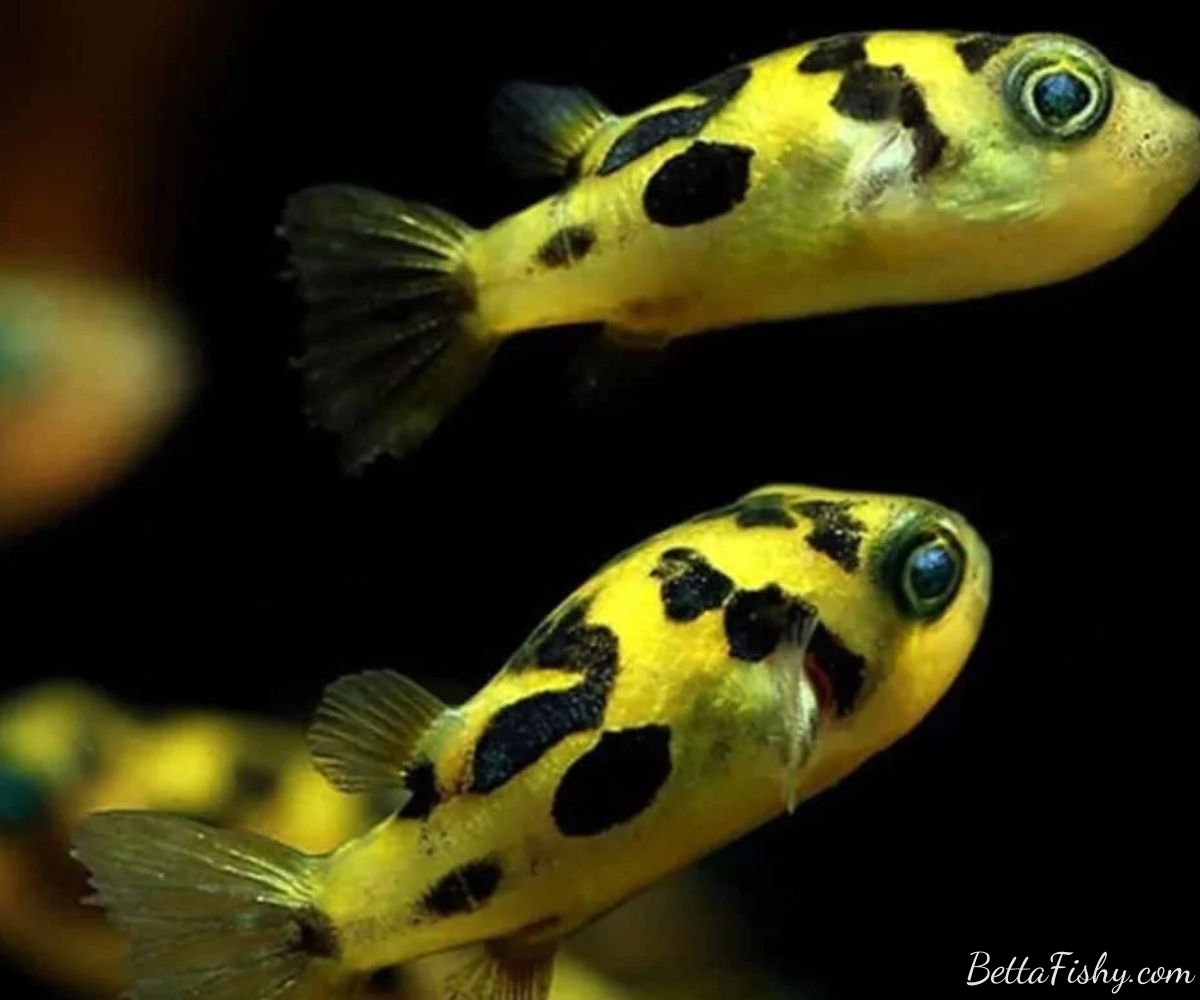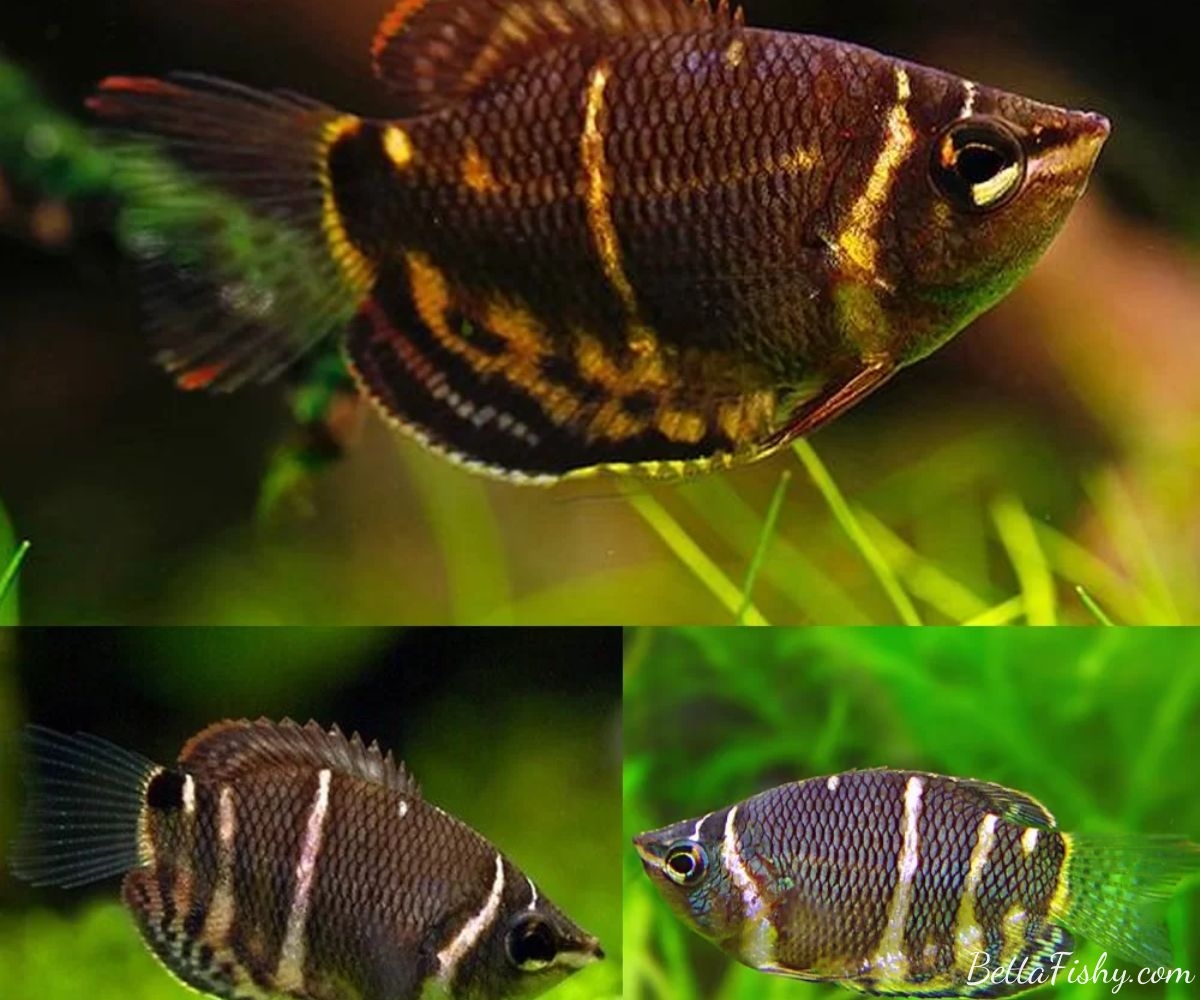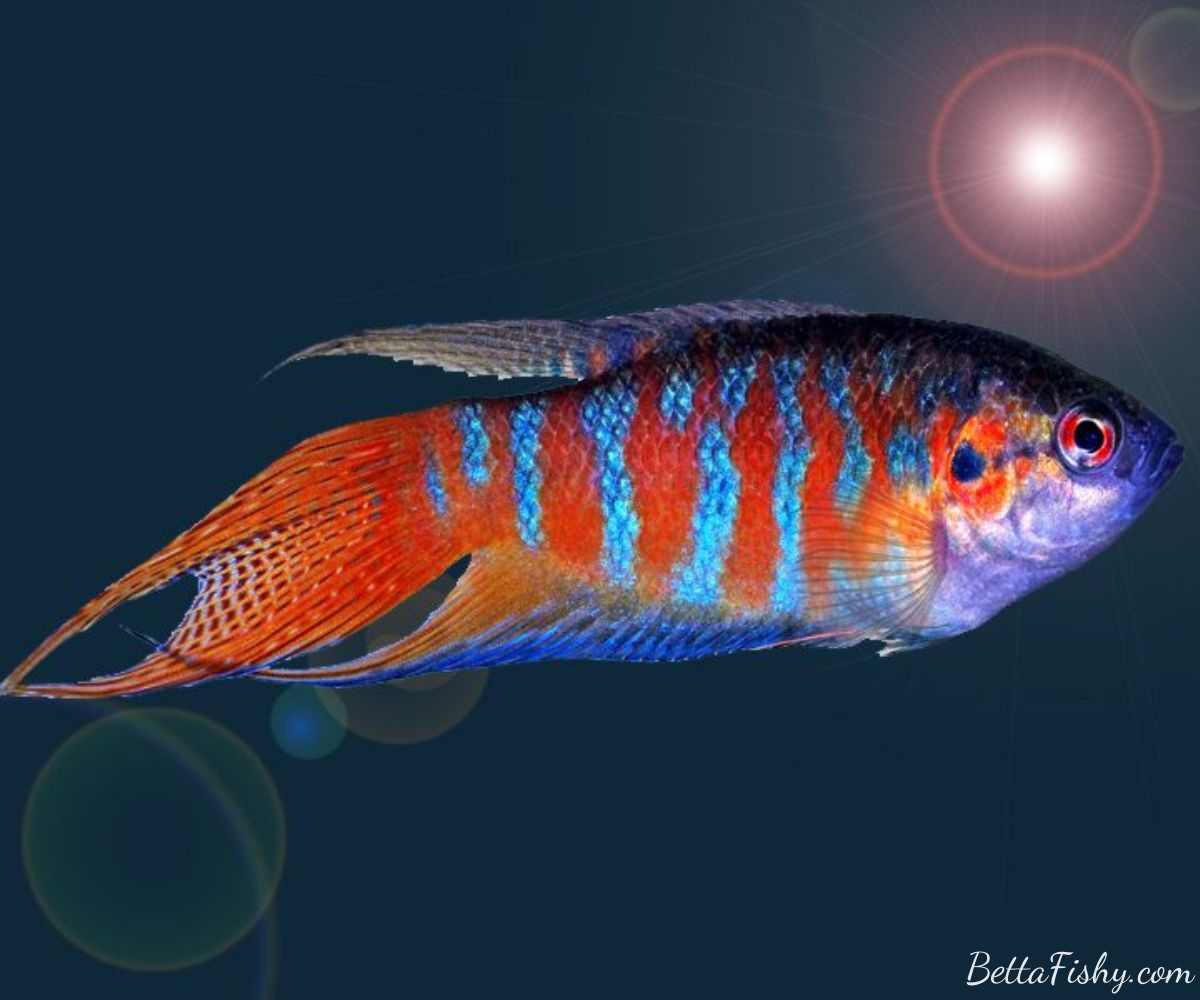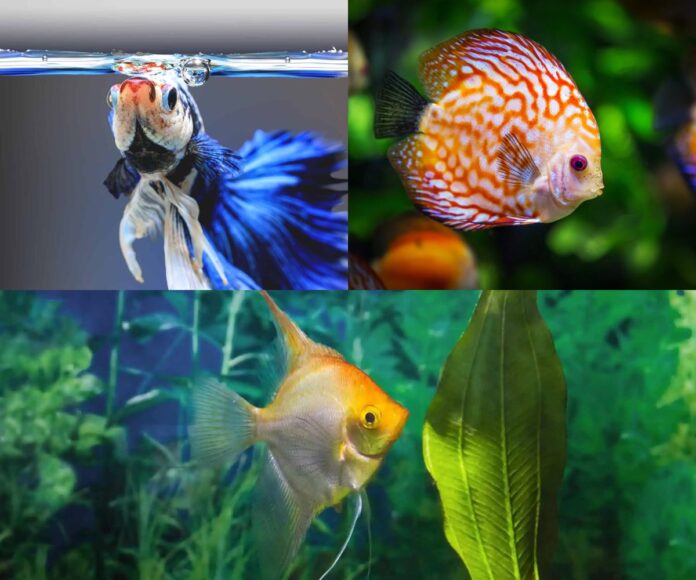In the world of freshwater aquariums, there is a diverse range of fish that thrive in different environments. While some species prefer to live in bustling communities, others prefer the tranquility of solitude. In this article, we will delve into the top 10 aquarium fish that like to be alone, exploring their unique characteristics and how to provide them with the best care possible.
Top 10 Aquarium fish that like to be alone
Pea Puffer: The Tiny Master of Stealth and Solitude

The Pea Puffer, also known as the Dwarf Puffer, is a small but mighty fish that hails from the rivulets and marshes of Southeast Asia. It has become increasingly popular among aquarium enthusiasts due to its charming personality and striking appearance. This solitary fish reaches a maximum length of only 1.3 inches, making it one of the smallest pufferfish species in the world.
Appearance and Behavior
The Pea Puffer’s body is elongated and cylindrical, with a distinct pointed snout. Its coloration can vary from olive green to vibrant orange, with black spots covering its body. These spots act as camouflage, allowing the fish to blend seamlessly into its surroundings. This makes the Pea Puffer a master of stealth, using its small size and clever disguise to avoid predators.
In terms of behavior, the Pea Puffer is known for its aggressive nature towards other fish. This is why it is best kept alone or in a species-only tank. However, they do well in community tanks with non-aggressive tankmates such as snails and shrimp.
Care and Tank Requirements
Pea Puffers are relatively easy to care for, making them a great choice for beginner aquarists. They require a minimum tank size of 10 gallons, with a pH level between 7.0-8.0 and a temperature range of 75-82°F. It is important to provide them with plenty of hiding places, such as plants and caves, as they are known to be shy and reclusive.
Pea Puffers are carnivorous and require a diet rich in protein. They have strong jaws and sharp teeth, which they use to crush snails and other small crustaceans. In captivity, they can be fed frozen or live foods such as bloodworms, brine shrimp, and daphnia. It is essential to vary their diet to ensure they receive all the necessary nutrients.
Honey Gourami: A Tapestry of Harmony and Serenity
The Honey Gourami, also known as the Sunset Gourami, is a peaceful and solitary fish that originates from the slow-moving rivers and streams of India and Bangladesh. Its name comes from its honey-colored body, which shimmers under the aquarium lights. This gourami species has become increasingly popular among aquarists due to its stunning appearance and docile nature.
Appearance and Behavior
The Honey Gourami has an elongated body with long, flowing fins. Its coloration ranges from a golden yellow to a deep orange, with iridescent scales that add to its beauty. Unlike other gourami species, the Honey Gourami does not have a labyrinth organ, meaning it cannot breathe air from the surface. Therefore, it is essential to maintain good water quality for this fish.
In terms of behavior, the Honey Gourami is a peaceful and timid fish. It prefers to spend most of its time alone, only coming out to feed or explore its surroundings. They are best kept in pairs or in a small group of one male and two females. Males can become territorial towards each other, so it is crucial to provide enough space and hiding places for them.
Care and Tank Requirements
Honey Gouramis require a minimum tank size of 10 gallons, with a pH level between 6.0-7.5 and a temperature range of 72-82°F. They are relatively hardy fish, but they can be sensitive to water parameters, so regular water changes are necessary. It is also essential to provide them with plenty of plants and decorations to mimic their natural habitat.
In terms of diet, Honey Gouramis are omnivorous and will eat a variety of foods. They can be fed high-quality flakes or pellets, as well as live or frozen foods such as bloodworms, brine shrimp, and daphnia. It is important to vary their diet to ensure they receive all the necessary nutrients.
Betta Fish: The Majestic King of Solitude

The Betta Fish, also known as Siamese Fighting Fish, is a solitary species that originates from the rice paddies and slow-moving streams of Southeast Asia. This beautiful fish has become a staple in the aquarium hobby due to its vibrant colors and unique personality. While male Bettas are known for their aggressive nature towards other males, they can thrive in solitude in a well-maintained tank.
Appearance and Behavior
Betta Fish come in a wide range of colors and tail types, making them one of the most visually striking fish in the aquarium world. Their long, flowing fins and vibrant colors have made them a favorite among aquarists. However, it is essential to note that male Bettas should not be kept together as they will fight to establish dominance.
In terms of behavior, Bettas are intelligent and curious fish. They are known to recognize their owners and can even be trained to perform simple tricks. They prefer to spend most of their time alone, only coming out to interact with their owners or explore their surroundings.
Care and Tank Requirements
Betta Fish require a minimum tank size of 5 gallons, with a pH level between 6.5-7.5 and a temperature range of 76-82°F. They are tropical fish and require a heater to maintain a stable temperature. It is important to provide them with plenty of hiding places, such as plants and decorations, to make them feel secure.
In terms of diet, Bettas are carnivorous and require a protein-rich diet. They can be fed high-quality pellets or flakes specifically designed for Bettas, as well as live or frozen foods such as bloodworms, brine shrimp, and daphnia. It is crucial to vary their diet to ensure they receive all the necessary nutrients.
Dwarf Pencilfish: A Delicate Beauty in Solitude
The Dwarf Pencilfish, also known as the Nannostomus marginatus, is a small and peaceful fish that originates from the Amazon Basin in South America. This delicate species has become increasingly popular among aquarists due to its unique appearance and calm demeanor. They prefer to live alone or in small groups, making them an excellent choice for a solitary tank.
Appearance and Behavior
The Dwarf Pencilfish has a slender, elongated body with a bright red stripe running along its side. Its fins are transparent, giving it a delicate and ethereal appearance. They are relatively shy fish and prefer to spend most of their time near the bottom of the tank. However, they can become more active and confident in a well-planted aquarium.
In terms of behavior, Dwarf Pencilfish are peaceful and do well with other non-aggressive fish. They are schooling fish, so it is best to keep them in groups of six or more. Males may display territorial behavior towards each other, but this can be minimized by providing enough space and hiding places.
Care and Tank Requirements
Dwarf Pencilfish require a minimum tank size of 10 gallons, with a pH level between 5.0-7.0 and a temperature range of 73-82°F. They are sensitive to water parameters, so regular water changes are necessary. It is also important to provide them with plenty of plants and decorations, as well as open swimming space.
In terms of diet, Dwarf Pencilfish are omnivorous and will eat a variety of foods. They can be fed high-quality flakes or pellets, as well as live or frozen foods such as bloodworms, brine shrimp, and daphnia. It is important to vary their diet to ensure they receive all the necessary nutrients.
Chocolate Gourami: A Rare Gem in Solitude

The Chocolate Gourami, also known as the Moonlight Gourami, is a solitary fish that originates from the peat swamps and slow-moving streams of Southeast Asia. This elusive species has become increasingly popular among experienced aquarists due to its unique appearance and challenging care requirements. They prefer to live alone, showcasing their stunning beauty in a peaceful and serene environment.
Appearance and Behavior
The Chocolate Gourami has a deep brown body with a metallic sheen, giving it a chocolate-like appearance. Its fins are long and flowing, adding to its elegant and graceful demeanor. They are relatively shy fish and prefer to spend most of their time near the bottom of the tank. However, they can become more active and confident in a well-planted aquarium.
In terms of behavior, Chocolate Gouramis are peaceful and do well with other non-aggressive fish. They are best kept in pairs, with one male and one female. Males may display territorial behavior towards each other, but this can be minimized by providing enough space and hiding places.
Care and Tank Requirements
Chocolate Gouramis require a minimum tank size of 20 gallons, with a pH level between 6.0-7.5 and a temperature range of 75-82°F. They are sensitive to water parameters, so regular water changes are necessary. It is also important to provide them with plenty of plants and decorations, as well as open swimming space.
In terms of diet, Chocolate Gouramis are omnivorous and will eat a variety of foods. They can be fed high-quality flakes or pellets, as well as live or frozen foods such as bloodworms, brine shrimp, and daphnia. It is important to vary their diet to ensure they receive all the necessary nutrients.
Rainbow Cichlid: A Colorful Solitary Beauty
The Rainbow Cichlid, also known as the Herotilapia multispinosa, is a solitary fish that originates from the rivers and streams of Central America. This stunning species has become increasingly popular among aquarists due to its vibrant colors and unique personality. They prefer to live alone, showcasing their full potential in a peaceful and serene environment.
Appearance and Behavior
The Rainbow Cichlid has a deep blue body with bright red markings on its fins. Its coloration can vary depending on its mood and surroundings, making it a fascinating addition to any aquarium. They are relatively shy fish and prefer to spend most of their time near the bottom of the tank. However, they can become more active and confident in a well-planted aquarium.
In terms of behavior, Rainbow Cichlids are peaceful and do well with other non-aggressive fish. They are best kept in pairs, with one male and one female. Males may display territorial behavior towards each other, but this can be minimized by providing enough space and hiding places.
Care and Tank Requirements
Rainbow Cichlids require a minimum tank size of 30 gallons, with a pH level between 7.0-8.0 and a temperature range of 72-82°F. They are sensitive to water parameters, so regular water changes are necessary. It is also important to provide them with plenty of plants and decorations, as well as open swimming space.
In terms of diet, Rainbow Cichlids are omnivorous and will eat a variety of foods. They can be fed high-quality flakes or pellets, as well as live or frozen foods such as bloodworms, brine shrimp, and daphnia. It is important to vary their diet to ensure they receive all the necessary nutrients.
Sparkling Gourami: A Shimmering Solitary Jewel
The Sparkling Gourami, also known as the Pygmy Gourami, is a small and peaceful fish that originates from the slow-moving streams and rice paddies of Southeast Asia. This delicate species has become increasingly popular among aquarists due to its unique appearance and calm demeanor. They prefer to live alone, showcasing their stunning beauty in a peaceful and serene environment.
Appearance and Behavior
The Sparkling Gourami has a slender, elongated body with a bright red stripe running along its side. Its fins are transparent, giving it a delicate and ethereal appearance. They are relatively shy fish and prefer to spend most of their time near the bottom of the tank. However, they can become more active and confident in a well-planted aquarium.
In terms of behavior, Sparkling Gouramis are peaceful and do well with other non-aggressive fish. They are schooling fish, so it is best to keep them in groups of six or more. Males may display territorial behavior towards each other, but this can be minimized by providing enough space and hiding places.
Care and Tank Requirements
Sparkling Gouramis require a minimum tank size of 10 gallons, with a pH level between 6.0-7.5 and a temperature range of 73-82°F. They are sensitive to water parameters, so regular water changes are necessary. It is also important to provide them with plenty of plants and decorations, as well as open swimming space.
In terms of diet, Sparkling Gouramis are omnivorous and will eat a variety of foods. They can be fed high-quality flakes or pellets, as well as live or frozen foods such as bloodworms, brine shrimp, and daphnia. It is important to vary their diet to ensure they receive all the necessary nutrients.
Zebra Danio (Longfin): A Striking Solitary Beauty
The Zebra Danio, also known as the Longfin Danio, is a peaceful and solitary fish that originates from the rivers and streams of India. This popular species has become a staple in the aquarium hobby due to its striking appearance and easy care requirements. They prefer to live alone, showcasing their full potential in a peaceful and serene environment.
Appearance and Behavior
The Zebra Danio has a slender, elongated body with bright blue stripes running along its sides. Its fins are long and flowing, adding to its elegant and graceful demeanor. They are relatively active fish and prefer to swim near the surface of the tank. However, they can become more confident and active in a well-planted aquarium.
In terms of behavior, Zebra Danios are peaceful and do well with other non-aggressive fish. They are schooling fish, so it is best to keep them in groups of six or more. Males may display territorial behavior towards each other, but this can be minimized by providing enough space and hiding places.
Care and Tank Requirements
Zebra Danios require a minimum tank size of 10 gallons, with a pH level between 6.5-7.5 and a temperature range of 64-75°F. They are hardy fish and can tolerate a wide range of water parameters. It is important to provide them with plenty of open swimming space, as well as plants and decorations for them to hide in.
In terms of diet, Zebra Danios are omnivorous and will eat a variety of foods. They can be fed high-quality flakes or pellets, as well as live or frozen foods such as bloodworms, brine shrimp, and daphnia. It is important to vary their diet to ensure they receive all the necessary nutrients.
Bolivian Ram: A Peaceful Solitary Cichlid
The Bolivian Ram, also known as the Mikrogeophagus altispinosus, is a peaceful and solitary fish that originates from the rivers and streams of South America. This stunning species has become increasingly popular among aquarists due to its vibrant colors and unique personality. They prefer to live alone, showcasing their full potential in a peaceful and serene environment.
Appearance and Behavior
The Bolivian Ram has a deep blue body with bright red markings on its fins. Its coloration can vary depending on its mood and surroundings, making it a fascinating addition to any aquarium. They are relatively shy fish and prefer to spend most of their time near the bottom of the tank. However, they can become more active and confident in a well-planted aquarium.
In terms of behavior, Bolivian Rams are peaceful and do well with other non-aggressive fish. They are best kept in pairs, with one male and one female. Males may display territorial behavior towards each other, but this can be minimized by providing enough space and hiding places.
Care and Tank Requirements
Bolivian Rams require a minimum tank size of 20 gallons, with a pH level between 6.0-7.5 and a temperature range of 75-82°F. They are sensitive to water parameters, so regular water changes are necessary. It is also important to provide them with plenty of plants and decorations, as well as open swimming space.
In terms of diet, Bolivian Rams are omnivorous and will eat a variety of foods. They can be fed high-quality flakes or pellets, as well as live or frozen foods such as bloodworms, brine shrimp, and daphnia. It is important to vary their diet to ensure they receive all the necessary nutrients.
Paradise Fish: A Colorful Solitary Beauty

The Paradise Fish, also known as the Macropodus opercularis, is a peaceful and solitary fish that originates from the slow-moving streams and rice paddies of Southeast Asia. This vibrant species has become increasingly popular among aquarists due to its striking colors and unique personality. They prefer to live alone, showcasing their full potential in a peaceful and serene environment.
Appearance and Behavior
The Paradise Fish has a deep red body with bright blue and green markings on its fins. Its coloration can vary depending on its mood and surroundings, making it a fascinating addition to any aquarium. They are relatively active fish and prefer to swim near the surface of the tank. However, they can become more confident and active in a well-planted aquarium.
In terms of behavior, Paradise Fish are peaceful and do well with other non-aggressive fish. They are best kept in pairs, with one male and one female. Males may display territorial behavior towards each other, but this can be minimized by providing enough space and hiding places.
Care and Tank Requirements
Paradise Fish require a minimum tank size of 20 gallons, with a pH level between 6.0-7.5 and a temperature range of 72-82°F. They are hardy fish and can tolerate a wide range of water parameters. It is important to provide them with plenty of open swimming space, as well as plants and decorations for them to hide in.
In terms of diet, Paradise Fish are omnivorous and will eat a variety of foods. They can be fed high-quality flakes or pellets, as well as live or frozen foods such as bloodworms, brine shrimp, and daphnia. It is important to vary their diet to ensure they receive all the necessary nutrients.
Tips for Keeping Solitary Fish
Keeping solitary fish requires special attention and care to ensure their health and well-being. Here are some tips to keep in mind when caring for these types of fish:
- Choose the right tank size and water parameters for each species. Each fish has specific requirements for tank size, pH levels, and temperature. It is important to research and understand these needs before adding a solitary fish to your aquarium.
- Provide ample hiding places and decorations. Solitary fish may become stressed if they do not have enough hiding places to retreat to. Adding plants, rocks, and other decorations can help create a comfortable and secure environment for them.
- Maintain good water quality through regular water changes. Solitary fish can be sensitive to changes in water parameters, so it is important to keep the tank clean and perform regular water changes to maintain good water quality.
- Monitor tankmates carefully to avoid aggression. While solitary fish prefer to live alone, they may still interact with other fish in the tank. It is important to monitor their behavior and remove any aggressive tankmates to prevent stress and potential harm.
Conclusion
In conclusion, there are many beautiful and unique fish that like to be alone. These solitary fish can make great additions to any aquarium, as long as their specific care requirements are met. By choosing the right tank size, providing ample hiding places, and maintaining good water quality, you can create a peaceful and serene environment for these stunning creatures to thrive in. Remember to always research and understand the needs of each species before adding them to your aquarium.


